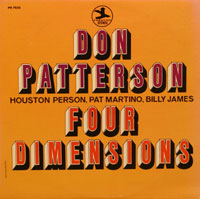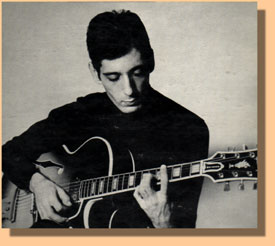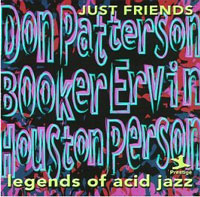

|
Soundclip:
|
| See Steve's Hand-Written Solo
Transcription |
|
Pat Martino's solo on: "Sandu"(Clifford Brown) It is truly amazing how marketing people in the music business continue to try to come-up with new terms to categorize various sub-genres, or more distasteful is that they will invent a new name for the sub-genre to simply create a new generation of customers. To me, such is the case with the term: "ACID JAZZ." What is that supposed to be? It seems to be a catch-all phrase that began by thowing together what used to referred to as "Soul Jazz", which was music that could not exactly stand next to the explorations of John Coltrane, Miles Davis, or Ornette Coleman, nor could it really stand next to the quiet dignity of the Bill Evans Trio. But, on the most positive side, this sub-genre did continue in the great traditions that married blues-based music with the improvisations of Jazz. It has a particular feeling to it, and most times included the Hammond B-3 organ.  Some of these organ greats included: Jimmy Smith; "Brother" Jack McDuff; "Big" John Patton; Richard "Groove" Holmes; Johnny "Hammond" Smith; Shirley Scott; Lonnie Smith; and Larry Young[mostly via his recorded work with Grant Green]. It would be impossible to make such a list without including the name of the Columbus, Ohio native, Don Patterson. During the mid-'60s he made a series of recordings for the Prestige label and seemed to always have the young guitarist Pat Martino by his side. Together, they recorded LPs for the Prestige label such as: "HOLIDAY SOUL"('65); "BOPPIN' & BURNIN'"('67); "OPUS DeDON""('68); "FUNK YOU!"('68); and, 1974's "THESE ARE SOULFUL DAYS"(Muse). For this edition, we are going to examine Pat's solo over the Clifford Brown blues in 'F', which has become a Jazz Standard, titled, "Sandu." It appears on the '68 release, "FOUR DIMENSIONS"(Prestige), a recording which featured a line-up that included: Houston Person: tenor sax and Billy James: drums. I would also want to make special mention of the fact that this LP was engineered by my dear friend Richard Alderson, who often captured, what I feel, are the best examples of Pat Martino's recorded sound, certainly from this important period of his work. Were I to venture a guess, I would even go so far as to say that I believe that what we now hear is all or mostly a direct signal on the guitar. Often times, if an engineer is having trouble recording someone's amplified sound, they ask if they can take a direct signal as well. Later, if it is a recording that actually gets mixed at a separate session, seasoned engineers could then run that same direct signal back out into the 'room' and through another amp, thus achieving a better clean sound. It is actually like re-recording it while mixing. When I listen to this recording, I just don't hear the guitar pumping a speaker at all, which is why I suspect that it was direct. Pat Martino's solo on "Sandu" is just 3 choruses in length. It is taken at a medium swing tempo. Normally, I would always want to write out any transcriptions using 4-bars per system. But, because of the double-time lines which begin in bar 9 of Chorus [2], for the sake of clarity, I decided to write it out the second two choruses using 3-bars per system. As I have stated before, these transcriptions were all done during my college years at U.C.L.A.('65-'69), and this particular one is one of several transcriptions that did not appear in my book "PAT MARTINO: The Early Years." In reviewing my work for presentation here, I found a few errors which, quite frankly, amazed me. I don't know how it happened, but I heard and then notated certain phrases incorrectly, mostly in the 1st chorus. And that one is the 'simple' one. It only goes to show that one can never have enough proof-readings of such things. There are always errors to be found. As Chorus [1] begins, Pat is following Houston Person's tenor sax solo which ends with a nice Stanley Turrentine-esque honk of an Ab on beat 3 of what is to be the 1st bar of Pat's solo. Perhaps, this caught Pat by surprise? Who can say? But, as he often did in 'the early years', Pat's solo does have a 1st chorus with some lyricism, and a clear development of a short idea or two. What is also nice to hear from him is that, during bars 8-11, the phrases are played with a distinctly laid-back feeling. This affords a wonderful contrast to the soon-to-come double-time phrases which are presented with Pat Martino's usual metronomic precision, and for that, they are spectacular of course. Even though a recording like this would clearly fall into the "Soul Jazz" category, the players cannot escape the modal sophistication that filtered into the genre.  So, one might expect to see certain key modal elements for the I7(F7) and the IV7(Bb7) chords. The mode of the root for F7 should always be F Mixolydian(F, G, A, Bb, C, D, Eb). But though the notes are actually the same, most players, schooled or not, expand the sonority by relating to it as C Dorian(C, D, Eb, F, G, A, Bb). For the Bb7, the mode based upon that root would be Bb Mixolydian(Bb, C, D, Eb, F, G, Ab), and the superimposition for it would then become F Dorian(F, G, Ab, Bb, C, D, Eb). One clever way to view the I7 and IV7 chords would be to see them as F Mixolydian changing to F Dorian in bar 5. If you choose to view a blues in that regard, the truth is that only ONE note changes! A-natural becomes Ab, while everything else remains the same! Of course, over both chords, one would expect to see that the F Blues Scale(F, Ab, [A], Bb, B, C, Eb) was employed. So, one might expect to see certain key modal elements for the I7(F7) and the IV7(Bb7) chords. The mode of the root for F7 should always be F Mixolydian(F, G, A, Bb, C, D, Eb). But though the notes are actually the same, most players, schooled or not, expand the sonority by relating to it as C Dorian(C, D, Eb, F, G, A, Bb). For the Bb7, the mode based upon that root would be Bb Mixolydian(Bb, C, D, Eb, F, G, Ab), and the superimposition for it would then become F Dorian(F, G, Ab, Bb, C, D, Eb). One clever way to view the I7 and IV7 chords would be to see them as F Mixolydian changing to F Dorian in bar 5. If you choose to view a blues in that regard, the truth is that only ONE note changes! A-natural becomes Ab, while everything else remains the same! Of course, over both chords, one would expect to see that the F Blues Scale(F, Ab, [A], Bb, B, C, Eb) was employed.Where the aforementioned modal superimposition is concerned, you can see and hear examples of this concept in Chorus [1] during bars: 5-6(F Dorian over Bb7); 7-8(C Dorian over F7). In Chorus [2] during bars: 4; 5; 9-10(G Dorian over C7). And, in Chorus [3], but with far more 'modal chromaticisim' during bars: 1-4(C Dorian over F7). As Chorus [4] begins and Pat launches into some chord solo work, you can clearly hear that he employs all Cm7 voicings over the F7 sonority, thus giving everything a more expansive harmonic feeling. At the end of the phrase, in bar 3, Pat plays an F7(13) voicing with 'F' on top. That is the only point of resolution. When playing a passage such as this, it is essential that your accompanying instrument, if there is an organ or a keyboard, is being played by someone who listens and, who will allow the harmonic space for you to explore those sounds and colors. If not, it is all going to be perceived as one giant harmonic jumble, in short, a mess!!! I think that a really mature and intelligent player might even lay out to allow you that space, or play much, much less. It really depends on everyone's sense of what is in good taste and what is not. In Chorus [2], Don Patterson's accompaniment takes on a 'riffin' the blues' style as he seems to 'loop' a blues-oriented lick in 3rds which begins on the 'blue note' of B-natural for a blues in 'F'. In this chorus, Pat introduces 'blues elements' which should appear in any blues. Examples of this are found in bars: 1-2 and 4-6. In Chorus [3], amidst the assault of 16th-notes, blues elements can still be heard in bar 5. Coming out of that line over the Bb7 chord, in bar 6, if one includes the pick-up high-'E' to the bar, the 1st beat is also another classic Martino-ism. As much so for the particular rhythmic grouping, as the outlining of Fm9(maj7) over the Bb7 sonority. On the 4th beat of bar 1, in this same Chorus, you see Pat doing something similar by applying virtually the same 'lick', except over F7, it becomes Cm9(maj7). I suppose that this is as good a moment as any to bring 'cycling' into the discussion as it forms such an important part of improvising in Jazz. The 'turnaround' as we return to the 'top' of any tune with form can be a specific set of changes or any variation, improvised or not, of I-VI7-iim7-V7-I. In the case of a blues, all the 'I' chords are dominant 7th types. So, in essence we would expect to see something like this: F7-D7(alt.)-Gm7-C7(alt.) returning to F7 in bar 1. It is also highly common to see G7 substituted for Gm7. As Jazz is and has been taught, formally and passed along via the 'oral traditions,' students are often advised to 'aim' for the 3rd of the chord when landing on it with their improvised lines. This is true even if one was to employ all b5 subs which might look like this: F7-Ab7-Db7-Gb7 and returning to F7 in bar 1. So, as these changes might arrive in a normal turnaround, you should expect to see 'A' on the F7; F# on the D7; Bb on the Gm7, or B-natural on the G7; and finally 'E' on the C7. In bar 11 of Chorus [2], on beat 3 you see Martino arrive on an F# as the D7 appears. Here you also see a most common device where altered chords are concerned, and that is that the 3rd is often quickly followed by the b9(Eb) or the #9(F). In bar 12 as the G7 arrives so does a B-natural on the downbeat. For the C7, an 'E' appears right on beat 4. In Chorus [3], in bar 11 an F# appears on beat 3 with the D7, and then in bar 12, a Bb on the downbeat indicates that Gm7 was the target. It should also be noted that one can 'cycle' without using the alterations, and in bar 9 of Chorus [3], over a G7 sonority, Pat plays B-D-F-A and down to 'G'. You also see Pat using a very characteristic line shape over F7 where he plays C-Bb-G-G# leading into 'A', the 3rd of F7. He does this in Chorus [2] in bar 11, and again in Chorus [3] in bar 1. At the end of Chorus [2] in bar 12, he uses a similar configuration of G-F-D-D# up to 'E' as G7 moves to a C7. Also, in Chorus [3] in bar 9, as D7 approaches G7, you see D-C-A-A# to B-natural. You see this exact same configuration as bar 11 goes into 12. Again, this is all highly traditional and important to have in your basic linear vocabulary. You can also find a classic Martino-ism in the long lines in bars 9-10 in Chorus [2] over C7. This line always begins on the 6th or 13th degree. In this case that means it begins on an 'A'-natural. On this particular solo, Pat, after landing on the 3rd of a C7 sonority, vaults up to the #9(Eb), down to the b9(Db) and resolves to 'C' for the F7 chord. This can be observed in Chorus [2] on the last beat of bars 10 and 12; and in Chorus [3] on the last beat of bar 10 again. During the course of the solo, I really don't see any usage of the altered dominant scale nor of the melodic minor built 1/2-step above the root. The closest Pat comes to this is in bar 9 of Chorus [3] where you see/hear him extending the length of the D7(alt.) chord into that bar by playing a Ebmaj7(9) arpeggio which, if you view it as the upper extensions of Cm7 and then relate that to the Am7b5 chord which precedes the D7 chord, it all makes sense as he eventually resolves to a G7(9) arpeggio.  Demonstrating that even Pat Martino is human, the solo ends with what, I would say, is a huge mistake. As Pat concludes the single-note portion of his solo with a descending line in 3rds, he lands on what is probably the worst note one could play on dominant 7th chord, and that is the major 7th. Against F7, that would be an E-natural. So, you will hear just how awful the third of E & G sounds as the F7, with a pronounced Eb, is played. There's almost no way to cover that up or to 'skate' around it. But, when one is improvising, no matter how great one's proven skills might be, mistakes are going to happen. It is, of course, always unfortunate when they happen on a recording. As it turned out on this particular track, Don Patterson does not actually begin to play solo lines until bar 8 of what would have been Chorus [4] for Pat Martino. As I previously stated, it sounds as though a chord solo is about to begin, but, it dovetails neatly into more subdued comping behind the organ. Sadly, Don Patterson passed away on February 10th, 1988. Yet another death which came way too soon to the community of Jazz musicians. Hopefully, even if your orientation is the guitar, you might want to take the time to explore some of his recordings as a leader. Remember, many of them have been re-packaged with this rather stupid title of "Acid Jazz." I can at least tell you that "Sandu" appears on "LEGENDS OF ACID JAZZ - Just Friends"(Prestige) with all 5 tracks from the "FOUR DIMENSIONS" recording included, and, they appear first on the disc. Other such compilations are hit and miss at best on these details. As always, we hope that you'll enjoy this great F-blues solo, and will be inspired to return and explore what is offered here or at Korner 2. It all comes to you with our best wishes.
[Photo of Pat Martino by: Don Schlitten]
|